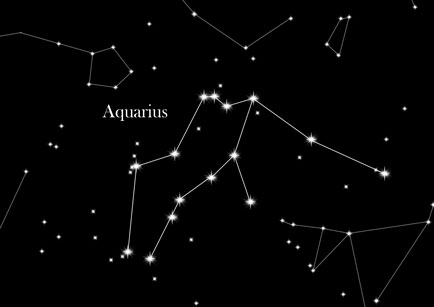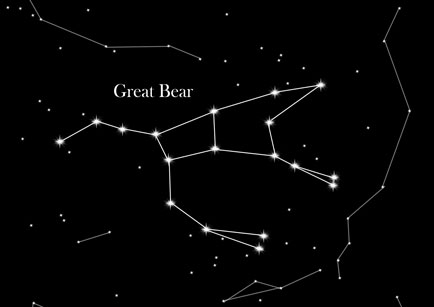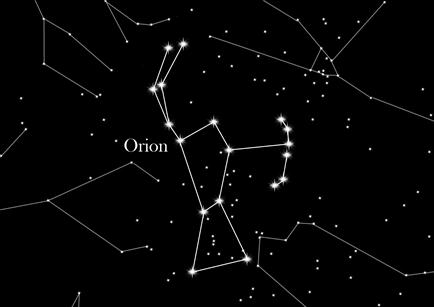The Aquarius is a large area, but rather faint constellation. Nevertheless, he is one of the oldest known constellations of the firmament and is a zodiac sign. For earlier cultures he marked the rainy season in the astronomical calendar, which gives an idea of the origin of its name and its historical significance. Aquarius is best seen from August to November.
Shape and position:
Aquarius is located south of Pegasus and is adjacent to several other constellations that are dedicated to water (Fishes, Whale, Southern Fish, Dolphin). It consists of very faint stars and is therefore difficult to recognize as a character. Beta Aquarii is the brightest star in Aquarius. His name Sadalsuud is of Arabic origin and means "the happiness of happiness." However, Alpha Aquarii has 6,000 times the luminosity of our sun, making it a true giant.
Right ascension: 20h 38m to 23h 56m
Declination: -25° to +3°
Brightest star: Beta Aquarii (Sadalsuud)
Mythology:
According to the legend Aquarius represents Deucalion, who survived the Flood and was the ancestor of the human race. As a kind of hellenic Noah he survived the floods of the angry Zeus and saved the civilization. According to other traditions Aquarius shows Kecrops I, the founder of Athens or Ganymede, Zeus' cupbearer. In more recent times the "Age of Aquarius" was much talked about. Basis is that the vernal equinox is about to leave the Fishes and move into Aquarius due to the precession since the middle of the last century.
Astrological significance: People who are born under the sign of Aquarius are considered to be gregarious and unconventional. They are rather extroverted than introverted and they are quick thinkers and not impressed by traditions. Often idealistic, freedom is their greatest asset.
Best time to observe: Fall
Neighboring constellations: Pegasus, Little Horse, Dolphin, Eagle, Goat, Southern Fish, Sculptor, Whale, Fishes
Buy a Star Blog
-
Star Sign Aquarius
-
Star Sign The Great Bear
The Ursa Major is popularly known as the Big Dipper. The Big Dipper is the most prominent constellation in the night sky, and one can look at this very large constellation throughout the entire year. In technical language, it is called "circumpolar". The Great Bear (Ursa Major is a Latin term which means "major bear") is a constellation of the northern sky and a very ancient constellation, which has already been known to the ancient Egyptians. Ursa Major has been mentioned by many famous poets such as Shakespeare, Tennyson and Homer.
Shape and position:
The Great Bear consists of a very large number of stars. The seven brightest stars of the constellation form a figure similar to that of a wagon. The entire constellation however looks like a bear, and consequently, the constellation is referred to by the general public as the Big Dipper. The "Wagon" is not a constellation itself, but an asterism, a very characteristic pattern in the sky, which itself is not considered a constellation. Ursa Major consists of many bright galaxies in the sky, including the pair Messier 81 (which is one of the brightest galaxies in the sky) and Messier 82.
Right ascension: 14h 08m to 8h 04m
Declination: +28° to +73°
Brightest star: Epsilon Ursae maioris (Alioth)
Mythology:
The mythology behind the constellation of Ursa Major is quite a tragedy. In Greek mythology, Zeus fell in love with a young woman named Callisto. They had a son named Arcas. Filled with jealousy, Hera, Zeus’s wife, transformed the beautiful woman into a bear. Later on, Callisto, while still in the form of a bear, encountered her own son Arcas. Arcas didn’t realize it was his mother and even tried to shoot the bear. To save Callisto, Zeus turned them both into bears and put in the sky, forming the Ursa Major.
Best season for observation: Year-round, with the best time in winter
Neighbouring constellations: Dragon, Lynx, Leo, Leo Minor, Coma Berenices, Hunting Dogs, Herdsman -
Star Sign Orion
Orion, also known as 'The Hunter' is one of the most striking and recognizable of the all the constellations in the night sky. One of the oldest constellations, located on the celestial equator, Orion is well known for its giant nebula, or star forming region. The character of Orion is that of a fierce hunter, carrying a sword, who is fighting off the attack of a bull with a swing of his club.
Shape and position:
Orion is located almost directly on the celestial equator, forming an imaginary extension of the equatorial plane. The constellation's main feature is its 'belt' of three stars, sometimes referred to as the 'Three Kings'. These stars, called Alnitak, Alnilam and Mintaka, are also occasionally referred to as 'Jacob's Ladder' or the cross staff. This 'belt' is most easily visible in the northern hemisphere during the month of January. Finding the three stars of the belt is the simplest way of locating the constellation in the sky. Orion's armpit and left foot are marked by two of the night sky's brightest stars. Betelgeuse, the armpit, is a bright red star, while Rigel, the foot, is the sixth brightest star in the sky.
Right ascension: 4h 45m to 6h 25m
Declination: +11 to +23°
Brightest star: Beta Orionis (Rigel)
Mythology:
The name of Orion comes from Greek mythology, where the hunter was primordial giant who wanted to marry Merope, daughter of the king of Chios, Oenopion. Although there are different versions of the tale, basically Oenopion refused and Orion was angry, and wanted to kill all the animals in the world as revenge. Gaia, the earth goddess, therefore sent a scorpion to poison Orion, terrified that he would carry out his threat. Artemis, the hunting goddess protected Orion by placing him on the opposite side of the sky to the scorpion. This is why the constellation Scorpio rises on the opposite side of the firmament to Orion and the two constellations are never seen in the night sky together.
Best season for observation: Winter
Neighbouring constellations: Bull, Eridanus, Twins, Lepis, Monoceros

